Among oxide semiconductors, p-type Mn3O4 systems have been exploited in chemo-resistive sensors for various analytes, but their use in the detection of H2, an important, though flammable, energy vector, has been scarcely investigated. Herein, we report for the first time on the plasma assisted-chemical vapor deposition (PA-CVD) of Mn3O4 nanomaterials, and on their on-top functionalization with Ag and SnO2 by radio frequency (RF)-sputtering, followed by air annealing. The obtained Mn3O4-Ag and Mn3O4-SnO2 nanocomposites were characterized by the occurrence of phase-pure tetragonal α-Mn3O4 (hausmannite) and a controlled Ag and SnO2 dispersion. The system functional properties were tested towards H2 sensing, yielding detection limits of 18 and 11 ppm for Mn3O4-Ag and Mn3O4-SnO2 specimens, three orders of magnitude lower than the H2 explosion threshold. These performances were accompanied by responses up to 25% to 500 ppm H2 at 200 °C, superior to bare Mn3O4, and good selectivity against CH4 and CO2 as potential interferents. A rationale for the observed behavior, based upon the concurrence of built-in Schottky (Mn3O4/Ag) and p-n junctions (Mn3O4/SnO2), and of a direct chemical interplay between the system components, is proposed to discuss the observed activity enhancement, which paves the way to the development of gas monitoring equipments for safety end-uses.
- Mn3O4
- Ag
- SnO2
- plasma assisted-chemical vapor deposition
- hydrogen gas sensors
1. Introduction
The reliable detection of hazardous/flammable gases is of key importance in a variety of fields, encompassing disease diagnosis, environmental monitoring and human health protection [1,2,3,4,5,6]. In this broad scenario, a key role is played by the early recognition of molecular hydrogen (H2), a zero-emission and clean fuel, with a high energy density of ≈130 MJ×kg−1 [2,7], which has emerged as a future energy source for transportation, industrial and residential applications [8,9,10]. Nevertheless, since H2 is colorless, odorless and highly flammable, the detection of hydrogen leakages at concentrations lower than hazardous levels [11,12,13,14] is extremely critical towards the emergence of a future hydrogen economy [7,8,15,16,17,18,19].
Simple architecture, cost-effective fabrication, stability under the operating conditions, and high efficiency, are the main requirements and core features of advanced sensors needed for such applications [16]. Among the various active systems and devices [20,21,22,23,24], metal oxide nanostructures have been the subject of an increasing interest, thanks to their high carrier mobility, easy fabrication and excellent stability [9,25,26,27,28]. In particular, whereas n-type oxide semiconductors have been largely investigated as gas sensors [8,9,12,15], p-type ones have not yet been widely studied [4,17,29,30], since their responses are typically lower than those of n-type systems with comparable morphology [31,32,33]. Nonetheless, p-type oxide semiconductors have an important potential as gas sensors, and represent promising platforms for the development of devices exhibiting new functions [32], taking into account their appreciable activity as oxidation catalysts and the possibility of boosting their performances by tailoring their chemico-physical properties [2,31,34,35].
Among p-type systems, Mn3O4 has received significant attention due to its low cost, large natural abundance, environmentally friendly character and versatile chemico-physical properties, including the coexistence of mixed valence states [36,37]. Over the last decade, different studies have reported on Mn3O4-containing gas sensors for various analytes, including CH3CH2OH, CH3COCH3, NH3 and chemical warfare agent simulants [31,35,36,37,38,39,40,41]. Nonetheless, only two works on Mn3O4-based gas sensors for molecular hydrogen detection are available in the literature so far [35,42], and the implementation of H2 sensors endowed with improved sensitivity and selectivity undoubtedly requires additional research efforts [29,35,37,38].
Beside tailoring the system morphology [25,26,33,39], a proficient way to enhance the functionality of bare Mn3O4 gas sensors involves their sensitization with suitable metal/oxide agents [8,18,35,42,43,44]. The ultimate aim of this strategy is the exploitation of synergistical chemical and electronic effects, in order to obtain improved performances at moderate working temperatures, an issue of key importance for the development of low power consumption devices [4,37,41]. In this context, the present study is devoted to the fabrication of Mn3O4-based chemo-resistive sensors for H2 detection, sensitized through the on-top deposition of selected metal and metal oxide activators. As prototypes for the two categories, in this work our attention has been focused on the use of Ag, a potential catalyst promoting the reactions involved in the sensing process [45,46,47,48,49], and of SnO2, by far one of the most investigated metal oxides for gas sensing applications, endowed with high electron mobility and gas sensitivity [10,13,25,26,50]. In particular, the occurrence of Schottky (Mn3O4/Ag) or p-n (Mn3O4/SnO2) junctions between the system components can indeed enhance the modulations of the space charge region, and of the measured electrical resistance, ultimately yielding improved sensing performances thanks to electronic effects [18,26,33,43].
At variance with our previous studies, which have involved the fabrication of Mn3O4-based sensors by means of thermally activated chemical vapor deposition (CVD)-based processes [31,38,39,41], in this work a novel two-step plasma-assisted route was adopted for the preparation of the present materials. The fabrication procedure (Figure 1) involved: (i) the initial plasma assisted-CVD (PA-CVD) on alumina substrates of MnO2 from Mn(hfa)2TMEDA (Hhfa = 1,1,1,5,5,5-hexafluoro-2,4-pentanedione; TMEDA = N,N,N’,N’-tetramethylethylenediamine) [51,52], a molecular precursor never utilized so far for PA-CVD processes; (ii) the functionalization with Ag or SnO2 by means of radio frequency (RF)-sputtering, and (iii) a final thermal treatment in air to trigger the transformation of MnO2 into Mn3O4. The main focus of the present investigation was directed at elucidating the structural, compositional and morphological characteristics of the target materials and their interplay with the resulting sensing performances in hydrogen detection. The latter were investigated at a fixed humidity level as a function of the operating temperature, with particular regard to the role exerted by the formation of metal-oxide (Mn3O4/Ag) or oxide-oxide (Mn3O4/SnO2) junctions. The obtained results indicate that the proposed preparation method yields H2 sensors exhibiting favorable detection limits, promising responses at moderate temperature, as well as selectivity against carbon dioxide and methane as potential interferents. To the best of our knowledge, this is the first report on hydrogen gas sensing by Mn3O4-based composites prepared by a plasma-assisted route.
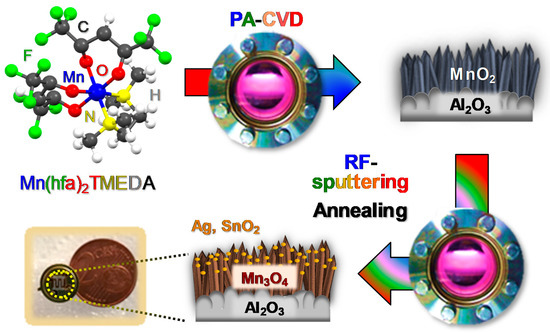
2. Results and Discussion
2.1. Chemico-Physical Characterization
The fabrication process of the target materials is illustrated in Figure 1. Particular efforts were dedicated to elucidating the interplay between the adopted processing conditions and material chemical, physical and functional properties.
The system structure was investigated by XRD analyses (Figure 2). All the observed reflections located at 2θ = 18.0°, 28.9°, 31.0°, 32.3° and 36.1° could be indexed to the (101), (112), (200), (103) and (211) planes of tetragonal hausmannite (α-Mn3O4; a = 5.762 Å and c = 9.470 Å [31,38,59]). The occurrence of relatively weak and broad diffraction peaks suggested the formation of defective nanocrystallites [11], whose average dimensions were close to 25 nm for all the target specimens. A comparison of the signal relative intensities with those of the reference pattern [59] did not reveal any significant orientation/texturing effect, and no appreciable reflections from other Mn oxide polymorphs could be distinguished, highlighting the occurrence of phase-pure systems. Upon functionalization of Mn3O4 by RF-sputtering, no net variation in the recorded XRD patterns took place. The absence of noticeable diffraction peaks related to Ag or SnO2 was traced back to their low content and high dispersion into the Mn3O4 systems [19,41,44,46] (see also XPS and SIMS results).
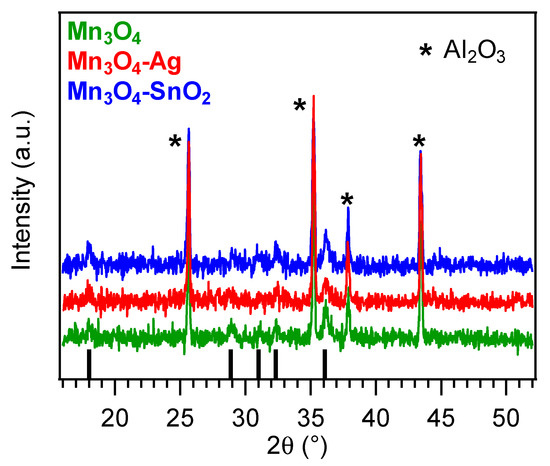
Figure 2. X-ray diffraction (XRD patterns for bare and functionalized Mn3O4 nanosystems. Vertical black bars correspond to α-Mn3O4 signals [59].
The surface chemical state of the developed materials was analyzed by means of XPS. Figure 3a displays the survey spectra for the target specimens, that revealed the presence of oxygen, manganese and eventually, silver or tin signals, for the functionalized systems, together with a minor carbon contribution (<10 at.%) resulting from adventitious contamination. The detection of manganese signals even after RF-sputtering suggested only a partial coverage of Mn3O4 by the deposited silver- and tin-containing species. Accordingly, Ag and Sn molar fractions were evaluated to be 47.0% and 31.0%, respectively. For bare Mn3O4, the Mn2p3/2 component was located at BE = 641.8 eV (spin-orbit splitting (SOS) = 11.5 eV, Figure 3b), in accordance with previous literature data [31,35,38,41]. For the functionalized systems, a lower Mn2p3/2 BE was observed (641.7 eV, for Mn3O4-Ag, and 641.5 eV, for Mn3O4-SnO2). This finding suggested the formation of Schottky and p-n junctions for Mn3O4-Ag and Mn3O4-SnO2, respectively [33,37,38,41,42], resulting in an Ag → Mn3O4 and SnO2 → Mn3O4 electron transfer. This phenomenon, more pronounced for SnO2-containing samples, as testified by the higher BE decrease, exerted a favorable influence on the resulting gas sensing performances. As regards silver (Figure 3c), the Ag3d5/2 position (BE = 368.5 eV, SOS = 6.0 eV), as well as the pertaining Auger parameters (see also Figure S1; α1 = 719.7 eV and α2 = 725.6 eV), revealed a partial Ag surface oxidation, i.e., the coexistence of Ag(0) and Ag(I) oxide, as typically observed in similar cases [38,46,49,60]. Finally, the main tin photopeak (Figure 3d; BE(Sn3d5/2) = 486.9 eV; SOS = 8.4 eV) was located at higher energies than those reported for SnO2 [14,56,61], in line with the above mentioned charge transfer process. Taken together, these results highlighted the formation of nanocomposites in which the single components maintained their chemical identity, and enabled us to discard the formation of ternary phases, in line with XRD results. The deconvolution of O1s photopeaks (Figure S2) revealed the concurrence of two distinct bands at BE = 530.0 eV, resulting from lattice oxygen in Mn3O4, Ag(I) oxide (Mn3O4-Ag) or SnO2 (Mn3O4-SnO2) [14,31,38,60,61], and 531.6 eV, assigned to oxygen species adsorbed on surface O defects [4,41,51,52,55]. The contribution of the latter component to the overall O1s signal increased from ≈36.0%, for bare Mn3O4, to ≈58.0%, for the functionalized specimens, indicating a parallel increase of the oxygen defect content. The latter feature had a direct beneficial impact on the resulting gas sensing behavior.
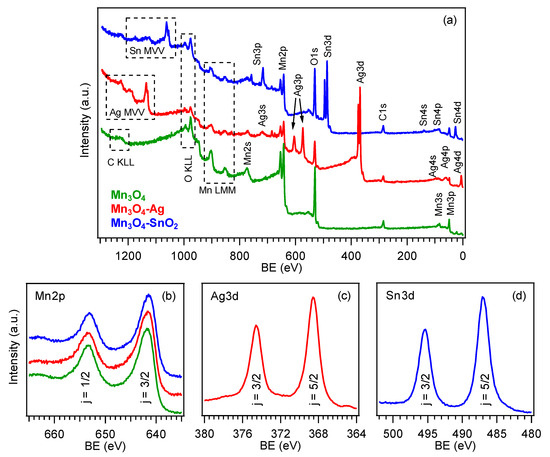
Figure 3. (a) X-ray photoelectron spectroscopy (XPS) wide-scan spectra pertaining to bare Mn3O4, Mn3O4-Ag and Mn3O4-SnO2 samples. (b) Mn2p, (c) Ag3d and (d) Sn3d photoelectron peaks. The color code is reported in panel (a).
Complementary information on material chemical composition was obtained by SIMS in-depth profiling (Figure 4). Upon functionalization of Mn3O4, no significant variations in the overall deposit thickness took place (for all specimens, the average value was (400 ± 50) nm, as determined by cross-sectional FE-SEM analyses (see below and Figure 5)). The almost parallel trends of manganese and oxygen ionic yields suggested their common chemical origin, in line with the formation of phase-pure Mn3O4. Silver and tin trends could be described by an erfchian profile, such as in thermal diffusion processes [49]. For the Mn3O4-SnO2 sample, Sn yield underwent a progressive decrease throughout the outer 100 nm, subsequently followed by a plateau, whereas, for the Mn3O4-Ag specimen, the silver curve continuously declined even at higher depth values. In spite of these differences, a penetration of both Ag and Sn up to the interface with the alumina substrate was observed, and ascribed to the synergistical combination between the inherent RF-sputtering infiltration power and the Mn3O4 deposit open morphology [38,41,44,48] (see also Figure 5). This intimate contact between the system components is indeed an issue of key importance in order to benefit from their mutual electronic interplay, as discussed in detail below.
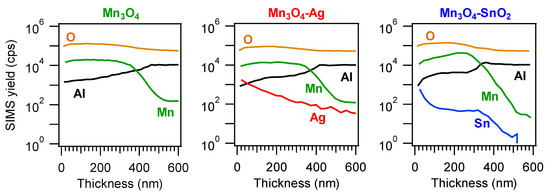
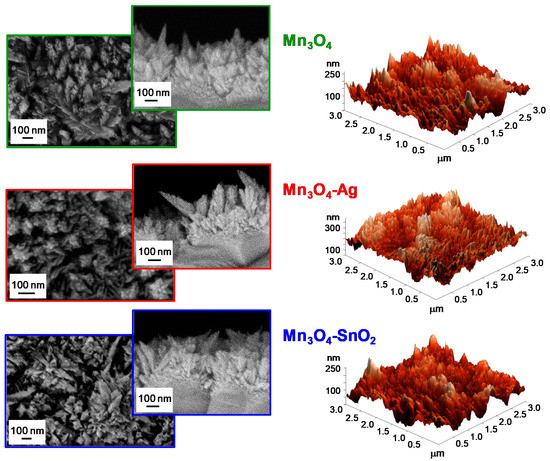
Figure 5. Representative plane-view and cross-sectional field emission-scanning electron microscopy (FE-SEM) micrographs (left panels) and atomic force microscopy (AFM) images (right panels) for Mn3O4, Mn3O4-Ag and Mn3O4-SnO2 samples.
The system morphology was investigated by the complementary use of FE-SEM and AFM. FE-SEM micrographs (see Figure 5, left side) highlighted that bare Mn3O4 was characterized by the presence of elongated nanoaggregates (mean size = 100 nm), whose interconnection resulted in the formation of arrays with an open morphology. This feature is indeed favorable in view of gas sensing applications, since a higher area available for the interaction with the surrounding gases has a beneficial effect on the ultimate material functional performances [15,19,25,31,40]. After Ag and SnO2 introduction, no marked variations involving aggregate coalescence/collapse could be observed, validating the potential of the adopted synthetic route in functionalizing Mn3O4 nano-deposits without any undesired morphological alteration. AFM analyses (Figure 5, right side) confirmed the presence of the aforementioned aggregates uniformly protruding from the growth substrate, resulting in a crack-free and homogeneous granular topography, yielding an average RMS surface roughness of 40 nm for all the analyzed specimens.
2.2. Gas Sensing Performances
Figure 6 displays representative dynamical responses of the developed sensors towards square concentration pulses of gaseous hydrogen. All the target materials exhibited a p-type sensing behavior, as indicated by the resistance increase upon H2 exposure due to the reaction of the analyte with adsorbed oxygen species, resulting in a decrease of the major p-type carrier concentration [2,16,31,35,39]. This phenomenon is in agreement with the fact that Mn3O4 is the main system component, as indicated by structural and compositional characterization [44].
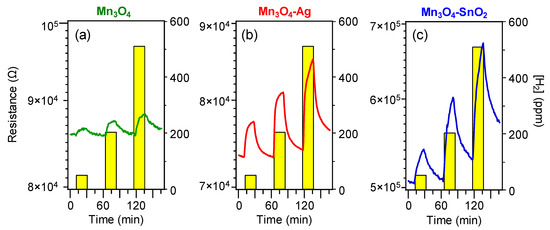
Figure 6. Dynamical responses of Mn3O4 (a), Mn3O4-Ag (b) and Mn3O4-SnO2 (c) nanosystems vs. different H2 concentrations, at a fixed working temperature of 200 °C.
Remarkably, data in Figure 6 evidence that the on-top deposition of Ag and SnO2 was an effective mean to increase the electrical property modulation upon H2 exposure with respect to pure Mn3O4. For both composite systems, the measured resistance underwent a relatively sharp rise upon hydrogen exposure, and a subsequent slower increase up to the end of each gas pulse. This phenomenon suggested that the rate-limiting step in the resistance change was the chemisorption of molecular hydrogen on the sensor surface [15,31,41,48]. In spite of an incomplete baseline recovery after switching off hydrogen pulses, the measured resistance variations were almost proportional to the used hydrogen concentrations, enabling us to rule out significant saturation effects, an important starting point for eventual practical applications [15,38,39].
To account for the performance increase yielded by composite systems, it is necessary to consider the mechanism of hydrogen detection by the target p-type materials, which can be described as follows. Upon air exposure prior to contact with the target analyte, oxygen molecules undergo chemisorption processes, yielding the formation of various species [6,9,29,36,43,55], among which O− is the prevailing one in the present working temperature interval [14,17,30,33]:
As a consequence, the formation of a low resistance hole accumulation layer (HAL) in the near surface Mn3O4 region takes place (Figure 7; HAL thickness = 20.6 nm, see the Supporting Information) [32,33,37,47]. The subsequent analyte chemisorption is accompanied by electron injection into the system conduction band [3,4,7,29,40,44,62]:
H2 (ads) + O− (ads) ⇄ H2O (g) + e−
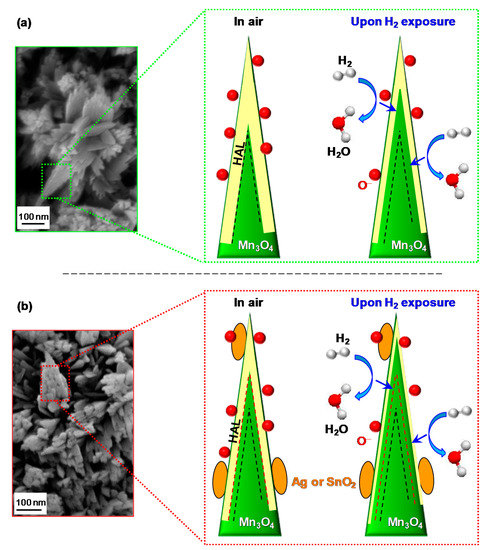
Figure 7. Schematics of the hydrogen gas sensing mechanism and corresponding hole accumulation layer (HAL) modulation for nanosystems based on: (a) bare Mn3O4; (b) functionalized Mn3O4. The dashed black and red lines indicate the HAL boundaries in air in case of bare and functionalized Mn3O4, respectively. Red spheres, yellow areas, and orange ovals indicate adsorbed oxygen, HAL thickness, and functionalizing agent (Ag or SnO2), respectively. Blue arrows indicate electron flow due to H2 oxidation (see reaction 4).
A process which decreases the hole concentration and the HAL thickness, resulting, in turn, in an increase of the measured resistance [5,16,17,18,42,43]. Finally, upon switching off the gas pulse, the sensor surface is again in contact with air, and the original situation is restored, with a recovery of the pristine HAL width [30,31,41].
Since all the investigated systems have almost identical mean crystallite dimensions, grain size and RMS roughness values, a significant influence of these parameters on the different gas sensing performances can be reasonably ruled out. Indeed, the enhanced responses of composite sensors with respect to the pristine Mn3O4 can be first explained in terms of electronic effects occurring at the interface between Mn3O4 and the functionalizing agents, a key aspect to be considered for a deep understanding of gas sensing phenomena [26].
For Mn3O4-Ag sensors, these processes result from the formation of Mn3O4/Ag Schottky junctions, whose occurrence produces a Ag → Mn3O4 electron flow [38,63] (see also the above XPS data), and a consequent thinning of the HAL width in comparison with bare Mn3O4 (compare Figure 7a,b). As a consequence, HAL variations upon contact of the sensor with gaseous H2 produce higher responses by increasing the registered resistance modulations [38,44]. An analogous phenomenon occurs for Mn3O4-SnO2 systems (Figure 7b; HAL thickness = 12.4 nm, see the Supporting Information), although in this case the SnO2 → Mn3O4 electron flow is triggered by a different phenomenon, i.e., the presence of p-n Mn3O4/SnO2 junctions [32,33,37,41,42,43,55].
The latter effect can, in principle, result in enhanced variations of the HAL extension with respect to the case of Mn3O4-Ag sensors, since the occurrence of a partial silver oxidation (as evidenced by XPS analysis, see above) precludes a full exploitation of electron transfer effects resulting from the establishment of Mn3O4/Ag Schottky junctions [38,46].
Nonetheless, the enhanced hydrogen detection efficiency of Mn3O4-based nanocomposites with respect to bare manganese oxide is likely due to the concurrence of additional cooperative phenomena. For both Mn3O4-Ag and Mn3O4-SnO2 systems, the higher content of oxygen defects at the composite surface with respect to bare Mn3O4 (see the above XPS data and Figure S2), as well as the exposure of a high density of heterointerfaces, can in fact supply active sites for a more efficient chemisorption of both oxygen and analyte molecules, which, in turn, boosts the resulting gas responses [4,8,16,17,18,30,43]. In addition, the intimate component contact enabled by the adopted preparation route, yielding a good intergranular coupling, enables a proficient exploitation of their chemical interplay [38,44,48], related to the synergistical combination of materials with different catalytic activities [10,27,37,41,47]. Hence, the improved sensing performances of functionalized Mn3O4 systems can be related to the concomitance of electronic and catalytic effects.
Taken together, the above observations can account for the improved performances at lower working temperatures of SnO2-containing systems with respect to Ag-containing ones. This result is exemplified by an inspection of Figure 8, showing that, apart from the appreciable response enhancement, deposition of Ag and SnO2 onto Mn3O4 resulted in different trends as a function of the operating temperature. In the case of Mn3O4-Ag sensors, the progressive response rise indicated an enhanced extent of reaction (4) upon increasing the thermal energy supply [2,8,15,31,38,39]. Conversely, as concerns Mn3O4-SnO2, a maximum-like response behavior was observed, the best operating temperature being 200 °C. Such a response trend, in line with previous reports regarding H2 detection by other metal oxides [7,9,17,19,29,43,64], suggested the occurrence of a steady equilibrium between hydrogen adsorption and desorption at 200 °C, whereas an increase of the working temperature resulted in a predominant analyte desorption [27,33,55,64,65]. The lower value of the optimum operating temperature for Mn3O4-SnO2 in comparison to Mn3O4-Ag is in line with the more efficient SnO2 → Mn3O4 electron transfer (see the above XPS data).
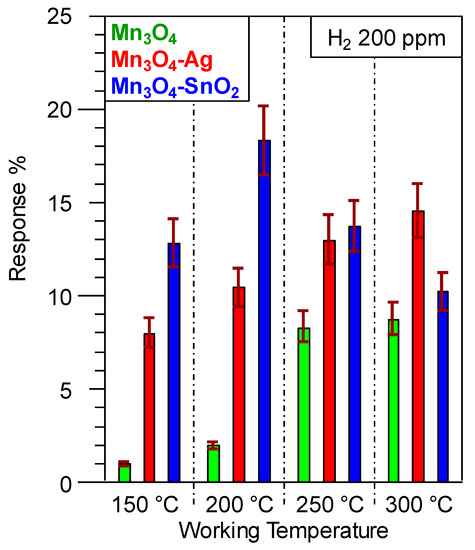
The potential of the present results is highlighted by the fact that the best H2 responses obtained for Mn3O4-Ag (at 300 °C) and Mn3O4-SnO2 (at 200 °C) were higher than those reported for sensors based not only on Mn3O4 [35,42], but even on other p-type oxides, including CuO [3,29], NiO [2,30], BiFeO3 [7], Co3O4 [16,19], NixCo3-xO4 [16], as well as nanocomposites based on CuO-Pt [4] and CuO-WO3 [18]. In addition, the same responses compared favorably with those pertaining to various MnO2-based nanomaterials/thin films in the detection of the same analyte [1,64,65]. A comparison of selected representative data is reported in Table S1. It is also worthwhile highlighting that the optimal operating temperature for H2 detection by the present materials (200 °C for Mn3O4-SnO2 systems) was lower than the ones reported for Mn3O4 [35], MnO2 [8], CuO [3,17,29], Co3O4 [16], NiO [9], NiO-ZnO [43], NixCo3-xO4 [16], BiFeO3 [7] and CuO-WO3 sensors [18]. This result is of importance, not only to avoid dangerous temperature-triggered explosions, but also to implement sensing devices with a higher service life and a lower power consumption [11,25,38,41].
Gas responses were also analyzed as a function of H2 concentration (Figure S3). The obtained linear trends in the log-log scale confirmed the absence of appreciable saturation phenomena, an important prerequisite for a quantitative analyte detection [37,38,39,44,48]. The best detection limits obtained by fitting experimental data with equation (2) ((18 ± 1) ppm and (11 ± 1) ppm for Mn3O4-Ag and Mn3O4-SnO2 sensors, respectively) were close to those previously reported for MnO2 [8], CoO [6] and CuO-TiO2-Au [44] sensors, and inferior than those pertaining to ZnO ones [15]. It is also worth noticing that these values were nearly three orders of magnitude lower than the H2 lower explosion limit (LEL, 40000 ppm) [2,11,12,23,43], highlighting thus the detection efficiency of the present systems.
Beyond sensitivity, selectivity is an important parameter for the eventual utilization of gas sensing devices [6,11,19,27,30]. The responses towards a specific test gas are in fact required to be higher than those of other potential interferents, in order to avoid false alarms in real-time gas monitoring equipment [36,38,39]. In particular, the choice of CH4 and CO2 as potential interferents in real-time hydrogen leak detection is motivated by the fact that: (i) hydrogen and methane are common reducing gases, either stored, or used together [1,13]; (ii) the presence of carbon dioxide may hamper hydrogen recognition [5,21,43] in the case of fuel cells eliminating CO2 and producing electricity and H2 [66]. As shown in Figure S4, the present sensors yielded no responses towards CO2, and only weak signals upon exposure to CH4. In the latter case, the selectivity was estimated as the ratio between the responses to H2 and CH4 [32,41], yielding values of 22 and 24 for Mn3O4-Ag and Mn3O4-SnO2 at the best working temperatures (300 and 200 °C, respectively). Though preliminary in nature, the latter results are an attractive starting point for further studies aimed at implementing exclusive H2 sensors, which are highly required for practical applications [13].
This entry is adapted from the peer-reviewed paper 10.3390/nano10030511
